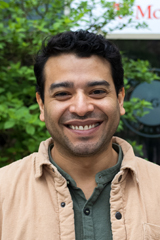Meet some of the 2025 recipients of Canada’s most prestigious graduate awards, exemplifying academic excellence across the full range of disciplines.
 Zaki Alasmar, Neuroscience
Zaki Alasmar, Neuroscience
Bridging the Neuroimaging Gap: Multiscale Approaches to Assess White Matter Microstructure and its Connectivity
The brain’s white matter is essential for healthy function but is often disrupted by disease. While diffusion MRI allows us to study the brain in living individuals, it provides an indirect view of its structure. Direct study of brain tissue postmortem offers greater accuracy, but makes comparisons difficult. Brain banks offer a way to bridge this gap by enabling comparisons across scales, from imaging to histology. My research, using the Douglas Bell-Canada Brain Bank, aims to strengthen this connection. I will develop a fast and reproducible method for scanning donated brains, then validate these scans by comparing them with microscopic tissue analysis to confirm their biological accuracy. Finally, I will extend the findings to a large set of lifespan scans to study how white matter changes with aging and disease. This research will provide new tools to connect brain scans with actual brain biology as a step towards personalised treatments.
 Joseph Chang, Music
Joseph Chang, Music
Analysis, Orchestration, and Performance of Synthesized Percussion Sounds from Music Composed for the Nintendo Entertainment System from 1983 to 1990
I analyze, arrange, and perform synthesized percussion sounds from soundtracks published for the Nintendo Entertainment System between 1983 and 1990. My research uncovers how seminal video game composers developed orchestration methods for percussion within the constraints of the NES’s Audio Processing Unit and explores how to adapt synthesized 8-bit music for acoustic percussion instruments. Most analytical methods in ludomusicology rely heavily on western notation, which is too limited to portray contrasts in sound colour. NES composers implemented music through assembly language, allowing sixteen variants per parameter. Signal processing methods reveal exact data, providing credible insight into composers’ musical choices.
Based on this analysis, I select the most representative soundtracks and perform them with an acoustic percussion ensemble. Adapting synthesized music for acoustic instruments presents challenges, including technical feasibility, and timbral recreation. My analysis and performance will advance comparative approaches in timbre and orchestration, and provide a helpful tool for composers.
 Zeinab Cherri, Epidemiology
Zeinab Cherri, Epidemiology
Estimating the causal effect of child marriage on mental health and sexually transmitted infections
Child marriage—defined by the United Nations as marriage before age 18—affects 650 million girls globally and remains a serious violation of human rights. Girls are disproportionately affected, reinforcing gender inequities in health, education, and economic opportunity. Rigorous research on the effects of child marriage on HIV seropositivity, intimate partner violence (IPV), and mental health remains limited. As such, major international organizations have called for further research to quantify these relationships.
My research addresses this gap by estimating the impact of child marriage on HIV, IPV, and mental health outcomes using nationally representative survey data from 38 low- and middle-income countries. I will assess whether marrying before age 18 increases the probability of experiencing these adverse outcomes. My findings will inform clinicians, policymakers, and public health practitioners about the unique risks faced by child brides and help design targeted interventions to reduce harm and protect child rights globally.
 Navid Ghassemi, Neuroscience
Navid Ghassemi, Neuroscience
Creating Foundation for Next-Generation Machine-Learning Tools for Automated Analysis of Rodent Behavioral Patterns in Home Cage Monitoring Systems
My project aims to develop a foundational AI model tailored for automated analysis of mice behavior to be integrated with Home Cage Monitoring (HCM) systems. Current behavioral studies rely on tests conducted outside mice's natural environments, introducing stress and limiting observation periods. By enabling continuous, stress-free monitoring directly within home cages, our AI-driven approach significantly reduces external influences, enhancing the accuracy and reproducibility of behavioral insights. This foundational model not only streamlines data analysis, making research faster, cheaper, and more accessible, but also facilitates large-scale, cross-institutional experimentation. Ultimately, this project supports advancements in drug development and neuroscience research, accelerating discoveries in mental disorders and brain function, and potentially benefiting millions by expediting the translation of experimental findings into clinical applications.
 Jose Arturo Jasso Chavez, Geography
Jose Arturo Jasso Chavez, Geography
Adopting Sufficientarianism in Transportation Studies: What Are the Minimum Levels of Accessibility Needed to Achieve a Good Quality of Life?
Accessibility, understood as the ease of reaching destinations, is a foundational concept in transport and land-use planning. It also plays a critical role in transportation equity, which provides a moral compass for evaluating how benefits and burdens are distributed. Transportation equity is commonly assessed through an egalitarian lens that seeks to reduce inequalities in accessibility across population groups. However, while addressing inequality is important, it does not ensure that everyone has sufficient access. Sufficientarianism, through the concept of accessibility poverty, can address this limitation by emphasizing the need to guarantee minimum levels of accessibility. Despite its normative relevance, sufficientarianism remains largely underexplored in transport research and planning. My work seeks to revisit sufficientarian ideas within accessibility studies and planning, quantify the minimum levels of accessibility to essential destinations required to avoid social exclusion and sustain well-being, and evaluate accessibility poverty in Montreal.
 Ninh Khuong, Epidemiology
Ninh Khuong, Epidemiology
The Use of Incretin-Based Drugs and SGLT-2 Inhibitors for the Prevention of Parkinson's Disease Among Patients with Type 2 Diabetes.
Patients with type 2 diabetes have an increased risk of developing Parkinson’s disease. However, it is uncertain whether lowering blood sugar can help prevent Parkinson’s disease in patients with diabetes. Some newer blood sugar lowering medications may have a direct effect on the brain and provide additional protection against Parkinson’s disease In my study, I will use a database with medical information to select patients with diabetes treated with the older medication and compare them to patients treated with the newer medications. The aim is to determine whether those treated with the newer medications are less diagnosed with Parkinson’s disease. This research will provide information on the potential benefit of the newer blood sugar lowering medications in preventing Parkinson’s disease. This study will also help to inform prescription choices in the management of individuals with type 2 diabetes and improve the future health outcomes of these patients.
 Austin Kraft, Linguistics
Austin Kraft, Linguistics
Forming complex noun phrases in Kanien'kéha, Pemalang Javanese, and Simpakng: A comparative study on underdocumented First Nations and Indonesian languages in service to community-led language vitality movements
Of the world's 7,000 languages, linguistics research has focused overwhelmingly on a tiny set of dominant languages. Countering this bias, detailed documentation of more languages will improve our generalizations about human language, and this documentation can support community-led language vitality.
Building on existing community relationships, I will research three understudied languages: Pemalang Javanese spoken in Central Java, Indonesia; Simpakng spoken in West Kalimantan, Indonesia; and Kanien’kéha spoken in modern-day Quebec, Ontario, and New York. These three languages differ in important ways from English and French: for example, they appear to lack one-to-one translations for articles like English ‘the.’ I will study these language’s strategies for creating noun phrases, namely in expressions of uniqueness, reflexivity, and measurement. From this work, I aim to (i) refine linguistic generalizations about how a noun phrase’s meaning is built from its parts; and (ii) share resulting documentation in learner-friendly, non-commercial formats with the respective communities.
 Camilo Miereles Salcedo, Anthropology
Camilo Miereles Salcedo, Anthropology
Resisting Silence: Everyday Practices, Non-Human Vibrancy, and Social Identities in Tepeticpac, Mexico (AD 1200-1519)
The misrepresentation of precolonial Tlaxcallan (AD 1200–1519) in Mexican historiography serves as a stark reminder of the systematic erasure of Indigenous identities from public memory by nationalist agendas worldwide. In the 16th century, Tlaxcallan resisted Aztec expansion for nearly a century before forming a strategic alliance with Spanish conquistadors. Yet early Mexican historians labeled the Tlaxcalteca as traitors, while glorifying the Aztecs as the primary Indigenous contributors to the nation’s heritage. As a Mexican archaeologist, I challenge this reductive narrative through collaborative work at Tepeticpac—one of the four principalities that comprised the Tlaxcallan coalition. In collaboration with the descendant community, I examine how daily practices and the influence of non-human beings mutually constituted social identities in Tepeticpac during its resistance to Aztec expansion. This project seeks to respectfully engage with traditional knowledge and co-create a more inclusive account of Indigenous identities and resistance to oppressive structures. Ultimately, this research offers a unique opportunity to advance decolonial practices within Mexican archaeology and to inspire similar efforts worldwide.
Jonathan Monro, Music
How opera artists’ perceptions of rehearsal communication might influence performance quality
 Elsa Nassar, Psychology
Elsa Nassar, Psychology
Partnering with Patients to Build an Evidence Base on the Best Methods for Communicating Research Results to Patients: A “Living” Evidence Synthesis and Series of “Learning” Trials
Research ethics guidance, both internationally and in Canada, requires that study results be shared with participants. The Canadian Institutes of Health Research’s Knowledge Translation Strategy also emphasizes the importance of disseminating results to patients more broadly, including those not directly involved in the original study. Effective dissemination can help build trust in research, encourage participation in research, and support patients in becoming more informed partners in their care. Yet most researchers do not share results with patients. A commonly cited barrier is uncertainty about how to present complex findings in an understandable format.
My research focuses on understanding how to best communicate research results to patients. I work in partnership with patients to identify, develop, and test dissemination strategies. This involves primary research, such as randomized controlled trials to test approaches, and evidence synthesis, as well as meta-research (i.e., research on research) to examine current dissemination practices.
 Thilor Ndiaye, Epidemiology
Thilor Ndiaye, Epidemiology
Estimating the Impact of the COVID-19 Pandemic on Ovarian Cancer Incidence, Treatment Volumes, Survival, and Inequalities in Canada
Ovarian cancer is the most lethal gynecologic malignancy, often diagnosed at an advanced stage due to vague symptoms and lack of early detection tools. Timely treatment is essential to improve outcomes. The COVID-19 pandemic disrupted cancer care across Canada, delaying diagnosis, surgery, chemotherapy, and follow-up, with many patients relying on telemedicine. These disruptions likely worsened ovarian cancer prognosis and may have disproportionately affected individuals from lower socioeconomic backgrounds. However, evidence on how these challenges influenced ovarian cancer outcomes across social groups remains limited. This study investigates the pandemic’s impact on ovarian cancer diagnosis, treatment, and survival in Canada, and examines disparities by socioeconomic status. The findings will provide critical insights into how healthcare disruptions affected this high-risk population and help guide interventions for other high-mortality cancers. Ultimately, this research aims to strengthen health system resilience and ensure equitable access to timely, high-quality cancer care in future public health emergencies.
 Kevin Prada, Psychology
Kevin Prada, Psychology
Called by Name: Design of a Novel Community-Based, Mindfulness-Based Intervention for 2SLGBTQ+ People with a Nonaffirming Religious Belief
Kevin Prada’s doctoral research explores how religiosity and spirituality shape the mental wellbeing of 2SLGBTQIA+ people in Canada. For many, spiritual and religious beliefs are powerful sources of meaning, connection, and identity. Yet when these beliefs are rooted in nonaffirming teachings, they can lead 2SLGBTQIA+ people to experience shame, isolation, and minority stress—factors linked to anxiety, depression, and reduced wellbeing. Through community-engaged interviews and collaboration, Kevin’s study seeks to better understand how 2SLGBTQIA+ people relate to and navigate their spiritual and religious experiences. These insights will inform the co-creation of a first-of-its-kind, 2SLGBTQIA+-affirming Mindfulness-Based Intervention (MBI)—specifically designed to support those who have experienced harm or exclusion within nonaffirming faith contexts. Grounded in intersectionality and participatory research, this project celebrates the diversity of 2SLGBTQIA+ lives and contributes to more compassionate mental health and spiritual care. It stands to make a significant contribution to both research and practice at the intersection of faith, identity, and wellness.
 Ella Sahlas, Neuroscience
Ella Sahlas, Neuroscience
Multimodal approaches for a more accurate and non-invasive identification of the epileptogenic zone
People with epilepsy experience reduced quality of life and increased risks of premature death, and over 30% suffer from seizures despite taking anti-seizure medication. In these cases, epilepsy surgery is the most effective treatment. However, only few of the patients who could be cured by surgery undergo this treatment. Increasing the number of patients who benefit from epilepsy surgery requires developing more precise and efficient ways to identify the area of the brain responsible for seizures in each patient, so that it can be removed while sparing nearby regions. My research combines non-invasive techniques to image the brain with high spatial and temporal precision, measuring abnormalities within and beyond areas of seizure activity. This will help advance methods for localizing the area responsible for seizures. My research also assesses potential changes in brain regions connected to this area, which could help explain why certain patients experience seizure recurrence after surgery.
 Molly Lechen Shen, Biological and Biomedical Engineering
Molly Lechen Shen, Biological and Biomedical Engineering
A 3D-printed Metastatic-Niche-on-a-Chip for Studying the Cancer-Stroma EV Crosstalk
The metastasis of cancer to distant organs accounts for the majority of cancer-related deaths, with certain cancers such as breast cancer displaying organ-specific metastasis known as organotropism. Extracellular vesicles (EVs), which are cell-derived, cargo-carrying “mini cells”, are increasingly recognized as key mediators in metastatic organotropism, prompting further investigation. Yet, current in vitro co-culture models fall short at capturing the dynamic reciprocity between cancer and stromal cells at the metastatic niche. Organ-on-a-Chip (OoC) technologies have emerged as a promising alternative to conventional animal models and 2D cell culture by leveraging microfabrication, microfluidics, and 3D cell culture techniques to mimic both native and diseased organ states. My research aims to develop a Metastatic-Niche-on-a-Chip to study the EV crosstalk between breast cancer and stroma cells at the metastatic niche. We hope to uncover crucial EV signatures associated with metastatic predisposition and shed light on the dynamic plasticity and co-adaptation between cancer and stroma.
 Charles St-Arnault, Electrical and Computer Engineering
Charles St-Arnault, Electrical and Computer Engineering
Programmable And Reconfigurable Large-Scale Photonic Computing Machines for Solving NP-Hard Problems, Enabling Major Multidisciplinary Breakthroughs
My research involves the use of photonic Ising machines to solve computationally intractable problems known as NP-hard problems. These problems lie at the forefront of major advancements across multiple research fields including drug discovery. The Ising model allows for such problems to be mapped onto a physical model represented by a lattice of spins enabling these problems to be solved by physical systems as an alternative to digital systems. However, physical Ising machines are slow, hard to scale and often the optimization of a large number of parameters, making them unsuitable for most applications. In contrast, photonic Ising machines use photons to represent the spin state of the problem lattice, providing high scalability, stability and computational speed. Using this photonic Ising machine, we have already successfully solved large-scale protein folding, number partitioning and prime number factorization problems.
 Xi Nicole Zhang,Computer Science
Xi Nicole Zhang,Computer Science
Precision Therapeutic Response Prediction: A Conditional Flow Matching Approach
Therapeutic treatments have come a long way, but there is still a significant number of patients who don't respond well to them. One of the challenges is that each person's genetic make-up and condition is unique, making it hard to predict how disease will progress and which treatment will work best. My research focuses on using probabilistic generative models to map and predict patient-specific trajectory. By predicting how disease evolves in each patient, physicians can design better, personalized treatments. This not only improves the chances of success but also offers insights into new potential therapeutics.
 This work is licensed under a
This work is licensed under a